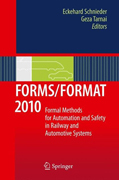
FORMS/FORMAT 2010: formal methods for automation and safety in railway and automotive systems
Schnieder, Eckehard
Tarnai, Geza
Complexity in automation- and safety systems in railway as well as automotiveapplications are dominated more and more by formal description means, methodsand tools. Formal techniques provide next to correctness and integrity checkups – especially for safety relevant systems – the possibility to model, prove,simulate and check the specification of the system as well as to generate thesystem implementations. Requirements of the CENELEC- and IEC-Standards on formal techniques, particularly with regard to the handling of safety analysis, are to be treated in FORMS/FORMAT 2010. The main focus lies on topics facing formal techniques for railway applications and intelligent transportation systems as well as for automotive applications. Gained findings, experiences and also difficulties associated with the handling of the subject matter as well as description means and tools are to be shown. The articles describe the latest development in the field of formal methods and description means. Authors from universities, from industries R&D departments and practitioners come together to share their ideas. Written by experts. INDICE: A Formal description means and methods – Concepts, Applications and Requirements in Traffic and Transportation (simulation, UML, Petrinets, AIS,etc.) B Requirements and Applications in Railway (signaling applications, model based design and analysis) C Requirements and Applications in Automotive and Vehicular Technology (control of driving dynamic systems, driver assistance;UML in automotive systems; model based development, diagnosis etc.) D Methodsand Tools for Modeling, Validation / Verification, Tests and Diagnosis (system related and functional validation, limits of formal methods, problems using automated tests etc.) E Legal framework (directives, laws, regulations, standards and norms, certification etc.) F Safety and Security (Reliability, Availability and Maintainability, methods for risk analysis; risk acceptance, risk measures, evaluation of RAMS-Parameter) G Human factors and human behaviour (learning, manipulation, FCR-modeling etc.)
- ISBN: 978-3-642-14260-4
- Editorial: Springer
- Encuadernacion: Cartoné
- Páginas: 480
- Fecha Publicación: 30/11/2010
- Nº Volúmenes: 1
- Idioma: Inglés
